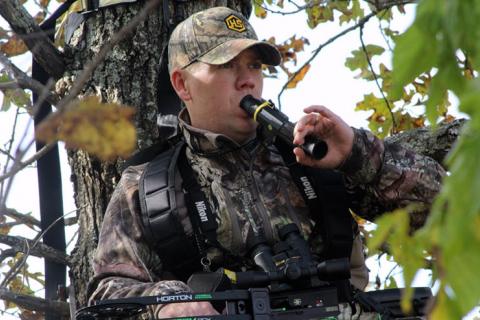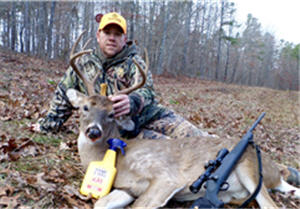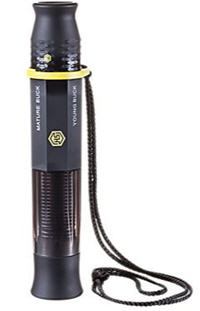
One of the most sought after pieces of equipment in a deer hunters arsenal is a grunt call, most hunters will have one within reach every time they're in the field. Other hunters, however, may have had a bad experience while using this call which makes them reluctant to try again. Over the years, I have made my fair share of mistakes in regards to calling in that big buck. Thankfully, the best way to learn how to do something successfully is by making mistakes and learning from them. Regardless if you are a first time user or a seasoned veteran, you can learn from some of the most common questions of when and how to use a deer grunt call.
 |
| The author with a buck taken in southern Missouri during the November firearms season. photo courtesy H. Wood |
![]() Deer Hunting Gear & Supplies Get your deer hunting gear, hunting supplies and hunting equipment from hunting stands, ammo, game cameras, camo clothing and more by shopping here at the Bass Pro Shops Deer Camp- Link.
Deer Hunting Gear & Supplies Get your deer hunting gear, hunting supplies and hunting equipment from hunting stands, ammo, game cameras, camo clothing and more by shopping here at the Bass Pro Shops Deer Camp- Link.
How To Use a Grunt Call
In my opinion, a grunt call is the same as a musical instrument. You use the same diaphragm muscles that you would use when making a sound on a flute. When you use less air it makes a softer sound, the same when using more air you get a louder more high-pitched sound. Those who have never used a grunt call, think of it as fogging a mirror with your breath, it doesn't take much air to get your desired sound. There are several different styles of calls on the market, all of which work differently and produce different vocalizations. Some use buttons that push on a reed in different positions to get different sounds. Some use a rubber 'O' ring style band that moves up and down the reed to change sounds from a fawn, to a doe, and even a buck.
![]() WATCH VIDEO: Grunt Call Techniques Video - LINK
WATCH VIDEO: Grunt Call Techniques Video - LINK
 |
| Hunter's Specialties Nemesis Deer Call |
![]() TIP: My call of choice is the Hunters Specialties Nemesis grunt call. This style of call is simple to use because of its ability to twist in a clock wise circle to change sounds to mimic the majority of sounds that whitetail deer make. After you learn how to get sounds of deer out of your desired call, it is important to control your volume in the woods. Start off low, then build volume up as you go. This will prevent spooking deer that might be at close range.
TIP: My call of choice is the Hunters Specialties Nemesis grunt call. This style of call is simple to use because of its ability to twist in a clock wise circle to change sounds to mimic the majority of sounds that whitetail deer make. After you learn how to get sounds of deer out of your desired call, it is important to control your volume in the woods. Start off low, then build volume up as you go. This will prevent spooking deer that might be at close range.
The Basics: Blind Calling & Visual Calling
There are two basics types of deer calling. The first type is blind calling, this takes place when there is no visual of deer, you are trying to call a deer into your area by using different calling sequences. My favorite time to do this style of calling is pre rut. When the bucks are fighting to see who the dominant buck in the area is going to be, as well as starting to search for does for the upcoming breeding season. Using different buck grunts imitates another buck in the area which triggers the dominance of mature bucks making them respond to see who has invaded their area. Using doe grunts, or bleats signals a buck to come in to see if a doe is in estrus yet. Visual calling is the opposite, this takes place when you can physically see a deer, then try to make them come into shooting range by making the same types of calls while blind calling. This type of calling works good for example if a buck is moving through your area, but in a different direction. You would then make a few calls to try to change his travel route.
![]() TIP: There are a lot of debates among hunters as to which of these two types of deer calling methods are the most effective. Some hunters say to only call when you can see the deer because you are putting attention on your location when making sounds. Whereas, by blind calling, a deer may sneak in and pick up on your location before you see them which makes them spook before a shot opportunity can develop.
TIP: There are a lot of debates among hunters as to which of these two types of deer calling methods are the most effective. Some hunters say to only call when you can see the deer because you are putting attention on your location when making sounds. Whereas, by blind calling, a deer may sneak in and pick up on your location before you see them which makes them spook before a shot opportunity can develop.
Calling During the Rut
The most frequent time that a grunt call is used is during the rut. This primarily is due to bucks being vocal and making several different types of sounds. However, there are two sounds that are arguably the most common. The first being a trailing grunt, which is a series of deep short grunts made by a buck while chasing a hot doe. I can relate this sound to a hog grunting while feeding. The first time I ever heard this particular sound in the woods I would have bet money it was a hog in the area because of the similarity in sound. The second is a tending grunt, which is the sound that a buck makes before breeding a doe. This call is usually made when the buck is within a few feet of a doe. It is a softer grunt, usually repeating two to three times in a sequence. This call can be used on a buck to make him think another buck is getting ready to breed one of his does, and can be used to break away a buck who may already be with a doe.
![]() TIP: The rut is the perfect time to learn the different types of vocals that bucks and does make. Deer (bucks and does) make a range of vocals during this time. Take notes of the sounds you hear and what they mean.
TIP: The rut is the perfect time to learn the different types of vocals that bucks and does make. Deer (bucks and does) make a range of vocals during this time. Take notes of the sounds you hear and what they mean.
![]() TIP: Learn to Adapt to These 7 Deer Rut Complications
TIP: Learn to Adapt to These 7 Deer Rut Complications
Adding Realism to Your Deer Calls
Adding realism to your calls goes back to listening to real deer while hunting. Try to mimic the sounds you hear, I am a big believer in practicing your calls. The better you sound the more effective you will be, realism matters, especially when it comes to mature bucks. Being as realistic as possible will fool the most experienced deer, even the ones that are more reluctant to come to a call. Adding realism can also mean adding other sounds along with your grunt call, such as rattling. Adding the sound of two bucks fighting along with a few grunts can be that turning point on making a buck commit to your call. Adding the sounds of leaves crunching, raking the bark of a tree, or rattling the brush can also add that extra bit of needed realism to your calls.
![]() TIP: Using inflection can up your odds when being realistic. Inflection is changing the monotone of your calls, it's having the ability to go high and low on one particular call. It's the same as when you and I talk, we don't talk in one tone we get high with our voice when we need attention and low with our voice when we are trying to soothe.
TIP: Using inflection can up your odds when being realistic. Inflection is changing the monotone of your calls, it's having the ability to go high and low on one particular call. It's the same as when you and I talk, we don't talk in one tone we get high with our voice when we need attention and low with our voice when we are trying to soothe.
Common Mistakes While Calling
One of the most common mistakes hunters make while using a grunt call is calling too much, especially when they are visual calling. It is so tempting to immediately go for your grunt call every time you see a buck.
- Pay attention to the body language of deer. For example, if a buck is just cruising through the woods in your direction, be patient and let him come. You'll want to grunt trying to get him into shooting range faster. If he is headed your way just let it happen on its own. By calling, you sometimes just give up your position. Try to wait until the buck is headed away before you call, never call when a buck is facing you because all you're doing is risking your location.
- Pay attention to the wind direction. The second mistake hunters often make is the wind direction. The wind should be in your favor when calling. If a buck is down wind from you and you call, he is most likely going to smell check and see if he can smell the deer that made the sound.
![]() TIP: Ways to Keep the Wind From Blowing Your Chances on a Buck
TIP: Ways to Keep the Wind From Blowing Your Chances on a Buck
Calling deer can be an exciting task if done at the right time. If I can give one piece of advice for new hunters wanting to use a grunt call it would be this, don't be afraid to use your call. However, before you do, think like a deer. Are you making the right sound for the situation you are in? Are you making the sound at a realistic volume, a realistic tone, and are you in a realistic situation?
{"preview_thumbnail":"http:\/\/afd-production-eru2ractomp34-gjdjeybzcubvfrgz.z01.azurefd.net/sites/default/files\/images\/videos\/109\/thumbs\/rpcMhaERQ84.mp4_00003.png\" scrolling=\"no","video_url":"https:\/\/1source.basspro.com\/video\/deer\/2082\/lure-bucks-these-grunt-call-techniques","settings":{"responsive":1,"width":"870","height":"490","autoplay":0},"settings_summary":"Embedded Video (Responsive)"}
- 10936 views

